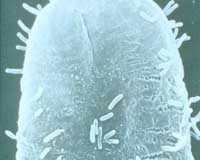 |
Washington DC (SPX) Dec 01, 2010 One of the worst pests of corn in the world, the corn rootworm, may owe its worldwide success partly to its larvae's nasty, sticky blood. U.S. Department of Agriculture (USDA) entomologist Jonathan G. Lundgren and his colleagues discovered this recently, working with CABI researchers in Delemont, Switzerland, and Hodmezovasarhely, Hungary. The discovery could lead to development of ways to overcome these defenses as part of sustainable, ecologically based pest management methods. Lundgren works at the Agricultural Research Service (ARS) North Central Agricultural Research Laboratory in Brookings, S.D. ARS is USDA's principal intramural scientific research agency, and this research supports the USDA priority of promoting international food security. CABI is an international not-for-profit organization that researches natural ways of controlling pests, and they have been helping to lead the effort against corn rootworm's European invasion. The experiments with CABI are the latest in Lundgren's research on corn rootworm predators. Although rootworms have been a major pest for 100 years, this is remarkably the first comprehensive research program on corn rootworm predators to be conducted. In lab and field experiments in the United States and abroad, the rootworm larvae's sticky blood caused certain species of predators to quickly back off. The foul-tasting blood coagulated in the predators' mouths, temporarily gluing them shut. Predators repelled by the rootworm larvae's blood included ground beetles and ants. Wolf spiders, on the other hand, had a hearty appetite for rootworms. When insects such as spiders suck fluids from prey rather than chewing their victims, they may be able to bypass the ability of the blood to stick and linger. The experiments with CABI involved two years of lab and field experiments, begun in 2007, in the United States and Hungary. In the Brookings laboratory, Lundgren and colleagues offered hungry predators a smorgasbord of rootworm larvae and pupae. In all, they have tested 10 different predator species from Europe and North America. The results have led Lundgren to research managing crop fields to encourage large and diverse predator populations. Papers on this research have been published recently in Biocontrol Science and Technology, Ecological Applications, and the Journal of Applied Entomology. Also, a paper is scheduled for publication in Environmental Entomology. Read more about the research in the November/December 2010 issue of Agricultural Research magazine, available online.
Share This Article With Planet Earth
Related Links U.S. Department of Agriculture (USDA) Farming Today - Suppliers and Technology
 Soil Microbes Define Dangerous Rates Of Climate Change
Soil Microbes Define Dangerous Rates Of Climate ChangeExeter, UK (SPX) Nov 30, 2010 The rate of global warming could lead to a rapid release of carbon from peatlands that would further accelerate global warming. Two recent studies published by the Mathematics Research Institute at the University of Exeter highlight the risk that this 'compost bomb' instability could pose, and calculate the conditions under which it could occur. The same Exeter team is now exploring ... read more |
|
| The content herein, unless otherwise known to be public domain, are Copyright 1995-2010 - SpaceDaily. AFP and UPI Wire Stories are copyright Agence France-Presse and United Press International. ESA Portal Reports are copyright European Space Agency. All NASA sourced material is public domain. Additional copyrights may apply in whole or part to other bona fide parties. Advertising does not imply endorsement,agreement or approval of any opinions, statements or information provided by SpaceDaily on any Web page published or hosted by SpaceDaily. Privacy Statement |